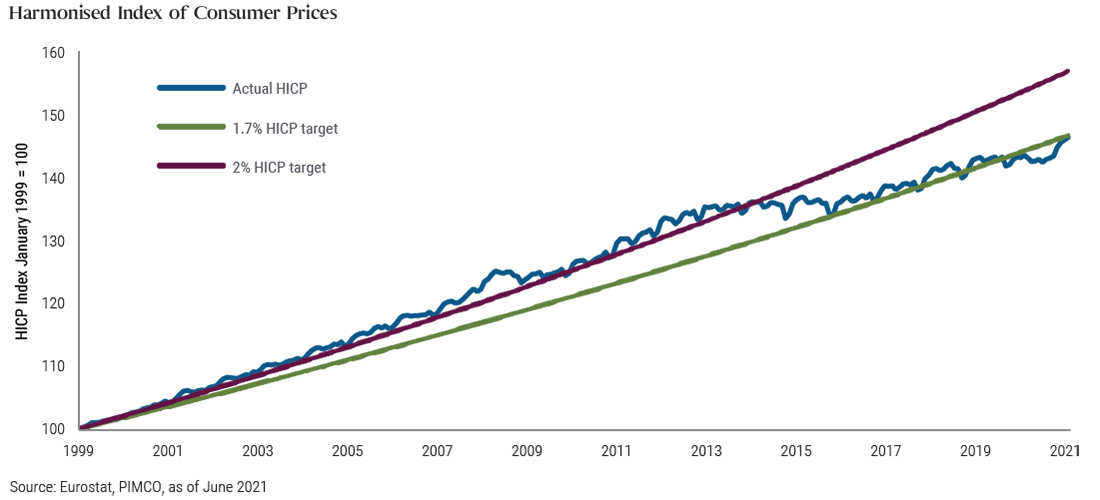ECB: New Inflation Target, Old Tools
In a surprisingly early conclusion of its monetary policy strategy review, the European Central Bank (ECB) rolled out several changes that will likely keep monetary policy easier for longer.
The good news: The ECB adopted an easy-to-understand, symmetric (i.e., negative and positive deviations of inflation are equally undesirable) 2% inflation target. The not so good news: The ECB did little to explain how it will achieve 2% inflation, other than committing to “especially forceful or persistent monetary policy measures to avoid negative deviations from the inflation target.” This creates a credibility issue that we think will leave inflation expectations subdued.
To its credit, the ECB has achieved price stability, albeit at lower rates in recent years. Today, the Harmonised Index of Consumer Prices (HICP) sits at a level equivalent to a 1.7% inflation. The ECB now wants to achieve 2%. The difference between 1.7% and 2% might sound like splitting hairs to some, but for monetary policy that primarily uses the blunt tool of interest rates to affect consumer prices, the difference is big. To begin with, the 1.7% average inflation realised so far encompasses two halves: While inflation averaged 2% during the decade following the euro’s founding in 1999, it has languished at only 1.3% on average since 2010. Had inflation evolved at a 2% rate throughout the entire period, the consumer price index would be 7% higher than it is today. The ECB stopped short of a commitment to make up for that previous undershooting.
In moving its medium-term inflation target up to 2%, the ECB invites the question of how it will achieve this more ambitious goal from such a low starting point while using the same old tools. While “forceful or persistent” monetary policy is probably a reference to the ECB’s pandemic emergency purchase programme and its regular asset purchase programme, the strategy review did not address specific methods to reach the 2% target. Setting a higher inflation target alone without altering the mix of policy therefore does little to assuage doubts that the ECB can achieve its new target. With the policy rate already at the effective lower bound, the ECB’s balance sheet bloated, and nothing new in the toolkit, we think inflation expectations will remain entrenched below 2%. Long-term, market-based measures of inflation expectations have hardly moved since the strategy review announcement and remain stuck around 1.5%.
In another decision, the ECB will immediately move to include initial estimates of owner-occupied housing costs in its inflation assessment. This welcome step ought to lead to a greater convergence of inflation rates between the euro area and countries, like the United States, which include owner-occupied housing costs in their inflation calculations. We estimate it will add about 0.1% to HICP inflation over time, bringing inflation closer to target. But the new target is now farther away, implying monetary policy ought to remain easier for longer.
The ECB also decided to consider the impact of climate change on price stability in its monetary policy strategy. Adding this objective lends institutional credibility to the Environment, Social and Governance (ESG) criteria increasingly used by investment managers and closely aligns the ECB’s and the European government’s policies. Green quantitative easing may feature more prominently in the future.
While asset prices have been very responsive to unconventional monetary policy, such as bond purchases, consumer prices have proved less reactive, probably owing to capacity in the labour market and productivity gains. An easier-for-longer policy should continue supporting risk assets, but without significant changes in the amplitude of the fiscal and monetary policy responses, it remains difficult for us to construct a credible scenario in which inflation sustainably rises toward the ECB’s new 2% target.

For our detailed outlook on the global economy and inflation in the year ahead, and its investment implications, please read, “Inflation Inflection.”
Andrew Bosomworth and Konstantin Veit are portfolio managers based in Munich. Both are contributors to the PIMCO blog.
Featured Participants
Disclosures
Statements concerning financial market trends or portfolio strategies are based on current market conditions, which will fluctuate. Outlook and strategies are subject to change without notice.
